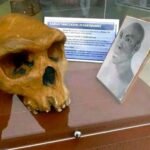Springhare
( cape springhare, springhaas )
- Pedetes capensis
- IUCN Status: Least Concern
- Trend: decreasing

- Kingdom: Animalia
- Phylum: Chordata
- Class: Mammalia
- Order: Rodentia
- Family: Pedetidae
- Genus: Pedetes
Share:
General Information
Similar to kangaroos, they are also saltatorial (having legs designed for jumping) animals who use their tails for balance.
Fun Facts
The Zambian springhare is the largest saltatorial rodent in southern Africa. Spring hares are the only mammals that have a septum in the lower trachea. This septum is otherwise only found in birds. Springhares are reported to be able to make hops of 20 cm and leaps of up to 3m. Springhare fur is biofluorescent. Their biofluorescence is patchy, with areas important to grooming and intra-specific interactions being the most biofluorescent. The recent discovery of biofluorescence in spring hares is a different phenomenon. Biofluorescence is the absorption of light at one wavelength and its re-emission at a longer wavelength. This means that biofluorescent animals can glow under ultraviolet light.
The biofluorescence of spring hares has not been fully studied, but it is thought to be caused by pigments in their fur. These pigments absorb ultraviolet light and then re-emit it at a longer wavelength, which is visible to the human eye.
It is not clear why spring hares have biofluorescent fur. Some scientists believe that it may help them to camouflage themselves from predators. Others believe that it may help them to communicate with each other.
More research is needed to understand the function of biofluorescence in spring hares.
Description
Springhares have long, soft fur, which shortens around their long hind legs, heads, and ears. The colour of this mammal varies from a reddish-brown on its upper-parts to an off-white belly and a black tip on the tail. Sometimes the ear tips are also black. Young springhares have finer and fluffier fur and usually have black patches of fur under their hind feet and in a patch of black under their tail base.- Length: 80 cm
- Weight: 2.7–3.5 kg
- Lifespan: up to 14 yrs in the wild
Ecology & Behaviour
springhares were found to have the capacity for minimal ear tissue regeneration. This regeneration is far behind to that of rabbits. Springhares are nocturnal animals, who forage during the night and retreat to a burrow during the day. While sleeping in their burrows, springhares sleep standing, with their head and forelimbs bent down in between their hind-legs, and their tail wrapped around their feet. Springhares are burrowing animals. They dig their own burrows on well-drained sandy soils, preferentially during the wet season.
They are solitary animals and only come together to mate. The gestation period for spring hares is about 78-82 days. Females give birth to a single young about three times a year, which is called a leveret.
Leverets are weaned at around 6 weeks old and become independent at around 1 year old.
Distribution & Habitat
They are particularly common in the Kafue National Park, but they can also be found in other national parks and game reserves, such as the Luangwa National Park, the Liuwa Plain National Park, and the Bangweulu Wetlands National Park.
Springhares are well-adapted to their semi-arid environment. They have long hind legs and powerful muscles that allow them to jump long distances, which helps them to avoid predators and find food. They also have a thick coat of fur that helps to protect them from the sun and cold.
Springhares are an important part of the Zambian ecosystem. They help to disperse seeds and control populations of insects. They are also a popular tourist attraction, and visitors can often see them foraging for food or playing in the grasslands.
Interaction with Humans
They are known to be hunted and eaten for their meat by some people and their fur used for garments, blankets, hats and their tails provides sinew for sewing and an ornamental belt which produces sounds can be made by tying springhare toes on a string
No donation to this project yet.
| M | T | W | T | F | S | S |
|---|---|---|---|---|---|---|
| 1 | 2 | 3 | 4 | 5 | 6 | |
| 7 | 8 | 9 | 10 | 11 | 12 | 13 |
| 14 | 15 | 16 | 17 | 18 | 19 | 20 |
| 21 | 22 | 23 | 24 | 25 | 26 | 27 |
| 28 | 29 | 30 | ||||

